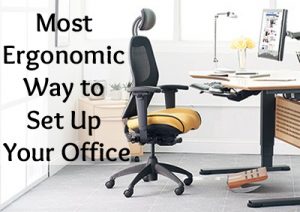Most Ergonomic Way to Set Up Your Office
 Ergonomics is, in a nutshell, the science of designing a work space to fit the worker, as opposed to forcing the worker to submit to the given parameters of a work space. Whether you spend your days wielding a jackhammer or a butcher knife, and whether you while away the hours in a kitchen or a cubicle, using tools and techniques that help prevent injury and promote the highest possible level of comfort is essential for your overall good health and for making sure you don't leave your desk job every day feeling like you did that one time you ran a triathlon.
Ergonomics is, in a nutshell, the science of designing a work space to fit the worker, as opposed to forcing the worker to submit to the given parameters of a work space. Whether you spend your days wielding a jackhammer or a butcher knife, and whether you while away the hours in a kitchen or a cubicle, using tools and techniques that help prevent injury and promote the highest possible level of comfort is essential for your overall good health and for making sure you don't leave your desk job every day feeling like you did that one time you ran a triathlon.
Companies large and small and far and wide are employing ergonomic principles to promote a safe and healthy work environment, which saves them money by increasing productivity and curbing the number of time you have to call in sick or work at a snail's pace because of your aching back, blinding headache, or throbbing arms and hands due to carpal tunnel syndrome.
Ergonomic workspaces ease the strain on your muscles, joints, bones, nerves, and tendons and help you maintain healthy eyesight and hearing. So if you find yourself slumping, hunching, schlepping, lumbering, straining, and sagging all over your work area, it's time to take a closer look and make these small — but serious — changes that'll improve your productivity and take a load off your poor, aching body.
Adjust your chair. If your chair isn't set at the right height for your body, it can put a strain on your neck and back muscles and cause nasty headaches. Adjust the height of your chair so that your feet are flat on the floor and your hips and knees are bent at 90-degree angles. If your chair doesn't go low enough let your feet rest on the floor, find something sturdy to rest your feet on. Keep your lower back against the back of the chair to help you maintain a healthy posture.
Situate your screen. Your computer screen should be 18 to 28 inches away from your eyes and situated directly in front of you so that you're facing straight ahead when using it. The top third of the screen should be just above eye level to keep you sitting up straight and to decrease the strain on your eyes. If you have to move your head up or down to see your screen, it's either too high or too low.
Get rid of the glare. If fluorescent lights or sunlight creates painful or annoying glare on your screen, turn off the overhead lights, if possible, or close the blinds. The brightest source of light should be to the side of your computer to prevent glare and ease the strain on your eyes.
Move the mouse. Keep your mouse right next to your keyboard so that it's easy to reach and your wrist is in a straight, relaxed, and comfortable position while you're using it.
Keep key tools within reach. Your telephone, stapler, paperclips, coffee cup — all of the things you use constantly while you're at your desk - should be within easy reach so that you're not always twisting in your chair or reaching up, down, or around to get to them. If you have to keep something slightly out of reach for any reason, stand up to retrieve it rather than straining — and potentially pulling — your muscles to reach it.
Wrangle a wrist rest. A wrist rest is an essential tool if you spend a lot of time tapping away on the keyboard. While you're typing, your wrists should be above the wrist rest, situated in a position that appears straight and feels natural, rather than bent up, down, or to the side. When you stop typing, the palms of your hands, and not your wrists, should rest on the wrist rest (which makes you wonder why it's called a wrist rest and not a hand rest.)
Slide on into a headset. If your job requires you to spend a lot of time on the phone, use a headset. The worst thing you can do for your neck and shoulders is to use them to cradle the receiver. Headsets come in a wide range of styles to suit both your fashion sense and your hearing needs.
Is your office set up ergonomically?


